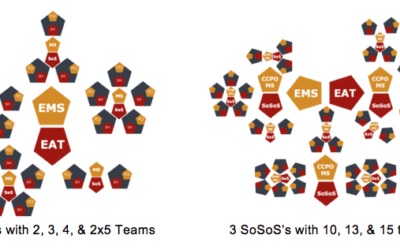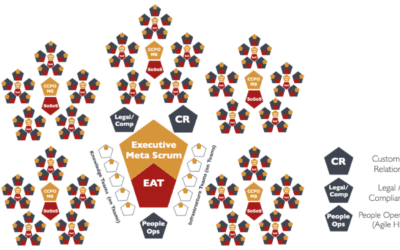Scaled Daily Scrum
Also known as: If applicable

Image Source: the official Scrum@Scale Guide
DP's CHANGE 1123AM
TESTING THIS CHANGE: The Scaled Daily Scrum is a daily, recurring event to enable multiple teams to coordinate their work more effectively. It involves at least one representative (typically a Scrum Master) from each team, who participates actively in the Scaled Daily Scrum shortly after their individual team's Daily Scrum. The maximum duration of the Scaled Daily Scrum is 15 minutes.
Related challenges: Process, Communication, Coordination, Delivery, Impediment Resolution
Description
The Scaled Daily Scrum is daily, recurring event to enable multiple teams to coordinate their work more effectively. It involves at least one representative (typically a Scrum Master) from each team, who participates actively in the Scaled Daily Scrum shortly after their individual team's Daily Scrum. The maximum duration of the Scaled Daily Scrum is 15 minutes.
The meeting aims to identify obstacles faced by each team, discuss any delays on one team that might affect other teams, manage or eliminate new dependencies, avoid future impediments, and share any notable learning that might benefit other teams. The topics discussed and the format of the meeting may differ depending on the framework.
The Scaled Daily Scrum is typically facilitated by a Scrum-of-Scrums Master (SoSM) who is elected to function as the Scrum Master for the team of teams. This meeting is part of the Scrum@Scale Framework.
Another similar meeting is the Coach Sync, which brings together the Scrum Masters (Team Coaches) from each of the team-of-teams at least once a week for 30 to 60 minutes to coordinate their work. The topics discussed are similar to those in the Scaled Daily Scrum. A Release Train Engineer (RTE) serves as the facilitator of the Coach Sync meeting. This meeting is part of the SAFe Framework.
When to Use
When to Use:
When there is an existing "Team of Teams" that need to coordinate to achieve a short-term objective, such as a Sprint goal.
When Not to Use:
When several disconnected teams need to deliver sprint objectives with few to no dependencies on other teams.
How to Use:
1. Identify one or more individuals who are strong in agile and your preferred framework.
2. Persuade them to participate in your agile scaling effort.
3. Form a team around these individuals.
4. Support the team in their efforts to become proficient (successful).
5. Once the first team is successful, form a second team, repeating the model until the entire organization has reached your desire level of agility.
How Not to Use:
- Avoid including everyone in problem solving
- Avoid regularly exceeding the timebox
- Avoid sending only the Scrum Master or always the same team member
Advantages and Disadvantages
Strengths:
- Fast identification of impediments requiring support
- Transparency on progress towards objectives
- Reduction in product and/or effort risk
- Reduction in surprises
Weaknesses:
- Requires additional time (e.g., 15 minutes) that some teams may interpret as unnecessary
- May be seen as a challenge to individual team self-organization and self-management
- May be seen as a challenge to the bureaucracy within an organization
- Real-time identification and communication of impediments removes the need for a separate meeting
A Working Example
At a large US government organization, an organization new to agile identified two individuals with prior experience with Scrum and recruited three others. They formed the first Scrum team at the organization. Once the team had completed six Sprints and was successfully delivering a working product, the organization added a second team by identifying one more experienced individual and recruiting five more from other agencies. They repeated this model until they had give teams, sufficient for a Scrum-of-Scrums.
Pattern Attribution
This pattern was created by Dr. Jeff Sutherland.
Page Contributor
The content in this Scaling Patterns Library is licensed under Creative Commons Attribution 4.0 International License.

